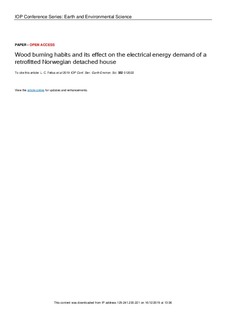| dc.contributor.author | Felius, Laurina C | |
| dc.contributor.author | Thalfeldt, Martin | |
| dc.contributor.author | Georges, Laurent | |
| dc.contributor.author | Hrynyszyn, Bozena Dorota | |
| dc.contributor.author | Dessen, Fredrik | |
| dc.contributor.author | Hassan Mohamed, Mohamed Hamdy | |
| dc.date.accessioned | 2019-12-17T08:01:58Z | |
| dc.date.available | 2019-12-17T08:01:58Z | |
| dc.date.created | 2019-11-04T11:47:11Z | |
| dc.date.issued | 2019 | |
| dc.identifier.issn | 1755-1307 | |
| dc.identifier.uri | http://hdl.handle.net/11250/2633510 | |
| dc.description.abstract | Using firewood as a space heating source is a popular solution in Norwegian housing and can significantly reduce the electrical energy demand of houses. This study analysed habits and reasons for using a wood stove from survey data. From this, typical behaviour patterns were defined. These patterns were imported into a building performance simulation model of a typical Norwegian single-family detached house to evaluate the impact of the stove user behaviour on the electrical energy demand and on the overheating risk. Results showed that up to 32% of the electrical energy demand for space heating can be saved using a wood stove. The number of overheating hours increased when the wood stove was used more frequently. However, it decreased after full renovation because the stove is used less often, as the total space heating demand decreases and the indoor temperature drops less often below the temperature set-point when the stove is started. Active use of the wood stove is effective as retrofitting measure when the aim is to save electricity or fossil fuels. Nevertheless, if the stove power is not adapted to the building, it can be challenging to maintain a comfortable temperature in the room. | nb_NO |
| dc.description.abstract | Wood burning habits and its effect on the electrical energy demand of a retrofitted Norwegian detached house | nb_NO |
| dc.language.iso | eng | nb_NO |
| dc.publisher | IOP Publishing | nb_NO |
| dc.relation.uri | https://iopscience.iop.org/article/10.1088/1755-1315/352/1/012022/pdf | |
| dc.rights | Navngivelse 4.0 Internasjonal | * |
| dc.rights.uri | http://creativecommons.org/licenses/by/4.0/deed.no | * |
| dc.subject | Energibruk i bygninger | nb_NO |
| dc.subject | Energy use in buildings | nb_NO |
| dc.title | Wood burning habits and its effect on the electrical energy demand of a retrofitted Norwegian detached house | nb_NO |
| dc.type | Journal article | nb_NO |
| dc.type | Peer reviewed | nb_NO |
| dc.description.version | publishedVersion | nb_NO |
| dc.subject.nsi | VDP::Arkitektur og bygningsteknologi: 531 | nb_NO |
| dc.subject.nsi | VDP::Architecture and building technology: 531 | nb_NO |
| dc.source.volume | 352 | nb_NO |
| dc.source.journal | IOP Conference Series: Earth and Environmental Science (EES) | nb_NO |
| dc.identifier.doi | 10.1088/1755-1315/352/1/012022 | |
| dc.identifier.cristin | 1743783 | |
| dc.relation.project | Norges forskningsråd: 257660 | nb_NO |
| dc.description.localcode | Content from this work may be used under the terms of theCreative Commons Attribution 3.0 licence. Any further distribution of this work must maintain attribution to the author(s) and the title of the work, journal citation and DOI. Published under licence by IOP Publishing Ltd | nb_NO |
| cristin.unitcode | 194,64,91,0 | |
| cristin.unitcode | 194,64,25,0 | |
| cristin.unitcode | 194,63,25,0 | |
| cristin.unitname | Institutt for bygg- og miljøteknikk | |
| cristin.unitname | Institutt for energi- og prosessteknikk | |
| cristin.unitname | Institutt for teknisk kybernetikk | |
| cristin.ispublished | true | |
| cristin.fulltext | original | |
| cristin.qualitycode | 1 | |

